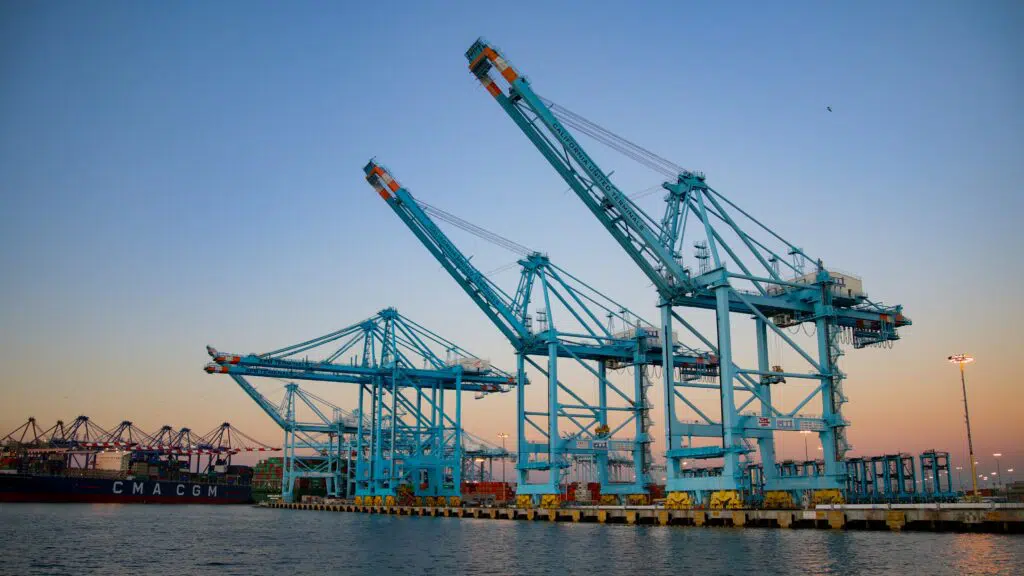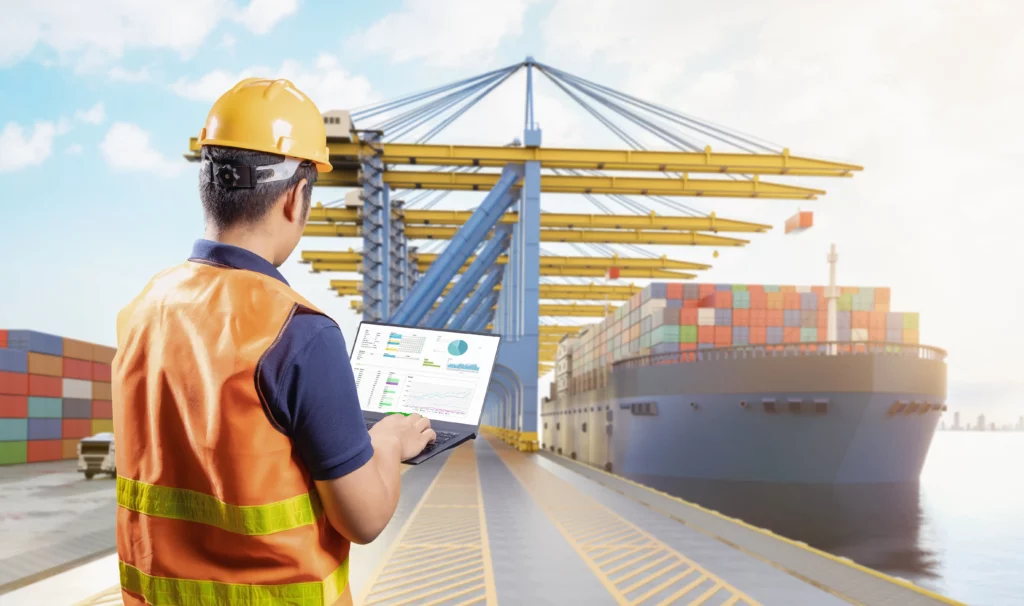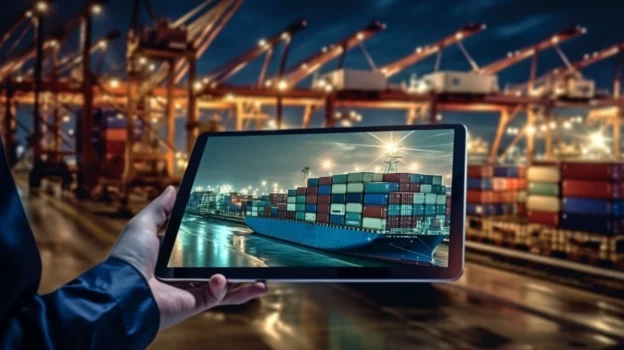Technological development has managed to impact each and every one of the commercial sectors and areas. Due to this, different industries are constantly innovating their processes to be able to compete in a market where efficiency is everything. One of the impacted sectors was the maritime sector, leading to the concept of smart ports1.
Automation, driven by technological advancement and growing demand for efficiency, is radically transforming seaports. Automated cranes and transportation systems, as well as intelligent management software, are increasingly integrated into terminals, causing a gradual shift of traditional manual tasks to a secondary focus, and ushering in a new era of intelligent terminals.
Currently, there is a lot of speculation about this type of maritime terminal and the future possibilities thanks to the arrival of new technologies. Therefore, in the following article we will study its evolution and development, benefits, challenges and implications involved in the adoption of the automated scheme.
What is maritime terminal automation?
They can be defined as ports that incorporate a high level of automation in their operations, such as cargo handling2 and product transportation, automation being understood as the delegation of manual work processes to machines that operate autonomously. An example of this type of infrastructure is the Port of Los Angeles, California; which opened its doors on December 9, 1907. In the figure, you can see a representative image of this port.

Its main purpose is to achieve high standards of efficiency and consistency in product handling, transportation and logistics processes. Additionally, it allows the reduction of errors due to human factors and loss of time due to personnel changes.
The automated terminal market has been constantly growing, and this is due to factors such as:
- Demand for increasingly larger ships.
- Increase in labor costs.
- Rise of international competition.
The constant demand for products and services that come from terminals has led the maritime sector to search for new proposals that allow it to meet market demands, without compromising the quality of the product/service. For this reason, automating the terminals was one of the ideal alternatives to achieve the objectives of this important industry, which continues to expand and cannot allow any type of error or failure.
Benefits of smart ports
Operational performance
This is the primary reason why companies want to implement this new concept. An automated terminal achieves greater operational efficiency by operating for greater amounts of time and through all types of conditions. On the other hand, thanks to the use of automated systems, it eliminates all types of uncertainty or inconvenience1, thus achieving a more orderly and methodical operation, facilitating operational control, enabling better decision-making in real time.
Costs reduction
Automating terminals commonly results in a decrease in costs associated with labor; which is a location-specific consideration and is heavily influenced by local labor costs as well as the level of automation leading to staff reduction. In environments with high labor costs, there is greater potential for savings through this new work scheme, as long as it effectively replaces workers.
This is one of the reasons why this concept has been implemented in countries with higher salaries. In lower-wage nations, automating may not make sense in terms of savings. However, the decrease in labor costs only materializes to the extent that automation effectively replaces labor.
Operational safety
Human failure can not only lead to loss of time and money, but can also be the trigger for some tragic event. Due to this, the mitigation of accidents through automation is one of the greatest benefits obtained by implementing this new work structure in the terminals.
Both people and maritime facilities can be insured thanks to automated terminals by eradicating errors resulting from human inconsistencies. Additionally, workers are protected when they are displaced from the areas where these computerized machinery operates.
Less environmental impact
The implementation of an automated system in a terminal improves its efficiency and minimizes delays, which leads to a decrease in fuel consumption3. This reduction in consumption will result in the minimization of carbon emissions generated by port facilities.
Another environmental advantage is the long life cycle of equipment in automated environments. Thanks to its lower replacement frequency, it generates a reduction in costs related to the manufacturing and transportation of new solutions, thus contributing to more sustainable management from an environmental point of view.
Transition challenges
- Initial investment costs: Implementing new technologies, mechanization and the adoption of automated systems represents a large investment that must be taken into account before developing a technological transition process. The reason for this is that automated equipment and machinery have a greater value compared to their versions that are operated manually.
- Equipment malfunction: Because a greater productive scope is projected for these machines, this would generate greater dependence on the optimal functioning of automated equipment. If these cannot operate correctly, it would have consequences such as congestion, traffic jams and reduced security in the facilities. To mitigate these possible scenarios, emergency plans will be needed to address potential equipment failures.
- Operations management: Changes in supply and demand traffic produce alterations in automated systems, causing asynchronies as a result. These changes in traffic and work must be considered prior to the implementation of automation both in ports and on ships. Additionally, it will be essential to have a logistical framework that can pay attention to these fluctuations to make changes as soon as possible.
Implications of its adoption
Smart ports can offer numerous advantages, but they also entail a number of implications that must be taken into account if an optimal transition to automated work is desired.
One of the main implications is the impact on the workforce, since this change would mean a decrease in demand for certain job positions. Due to which, there are certain labor sectors that oppose the complete automation of terminals.
As a way to encompass this implication, personnel relocation projects offer a relevant solution to this possible event. Additionally, these projects can also address the qualification of the work team to improve their skills4, and in this way, they can develop in new areas such as the management of the company’s automated processes (see figure 2).

Another aspect to take into account is the technological section, which includes different sectors that must be applied and used so that automated systems can function efficiently.
For the correct functioning of automated terminals, a logistics chain that uses innovative systems such as Artificial Intelligence, Blockchain and IoT will be needed. It is a detail of utmost importance since the maritime sector will have to acquire the ideal digital skills to manipulate these technologies, in order to ensure the good performance of the new work modality.
Likewise, the use of these new technologies will require a cybersecurity system as a guarantee against accidental failures and breakdowns, in the same way, said system would function as a way to ensure the integrity of the terminal data.
Examples of smart ports
Rotterdam Terminal
It is the largest port in all of Europe, being one of the most important industrial complexes in the maritime sector5. At the same time, it has one of the most innovative terminals of the moment.
One of the technologies used in the facilities is digital twins, mainly to generate a replica of the facilities and thus be able to study their operation. With this they can detect problems and also monitor the development of tasks.
They also use sensors to study different characteristics of the water, with the aim of being able to carry out their stipulated activities without any inconvenience. They are currently working on the transition towards green energy sources, becoming one of the references in that sector.
Hamburg Terminal
The renowned port city of Hamburg has recently been on a quest to ensure smooth and efficient operations at its port. For this reason, it has begun the implementation of initiatives to convert it into an automated terminal.
To achieve this, they have developed a philosophy known as smartPORT , which focuses on achieving economic growth in a sustainable way. As technological tools and instruments, they use sensors and analysis, forecasting and information systems, guaranteeing improvements in process efficiency as a result of their implementation.
The adoption of intelligent systems has not only allowed them to improve their processes, but also reduce their environmental impact. These systems have also managed to innovate the security and maintenance of equipment and facilities, thanks to recognition technologies that detect and recognize irregularities early.
Shanghai Terminal
It is the largest automated terminal in the world, and here you can find the “Yangshan Deep Water Port”, considered the busiest port in the world5. Due to its massive traffic, the terminal has implemented automation systems in its structure in different sectors and machines such as cranes, trucks and vehicles.
The way this terminal operates is through a data collection and processing system, which is transmitted to the machinery so that they can carry out the defined tasks with a high level of precision and effectiveness.
Implementing automation has not only helped them increase their operational efficiency, but has also allowed them to reduce their emissions. Finally, the focus on environmental well-being has led this terminal to project itself towards the development of smart and ecological ports.
The future of smart ports
Although there are a huge number of maritime terminals in the world, only a small percentage use automation in their facilities6. This may be due to factors such as resistance to change or one of the challenges covered above. However, it is only a matter of time before this new work system is increasingly adopted.
The main reason is the advantages it offers with respect to operational effectiveness and efficiency. However, the environmental factor is also important, since an increasingly sustainable and planet-friendly production scheme could be developed.
With constant technological advances, the automation of smart ports could reach levels that allow the development of operations in an optimal and safe way. Therefore, it is very likely that the demand for more efficient services will continue to grow, directing those terminals that have not yet begun their transition towards an automated approach if they wish to continue competing in the maritime market.
Conclusions
Smart ports, driven by technological development and the constant search for efficiency, is a concept that is projected as the progress of the maritime sector. This is largely due to its notable benefits such as increased operational performance, reduced labor costs, improved safety and positive environmental impact.
However, the transition to this model presents challenges and implications that include labor transformation and the need for technological skills. In the case of generating solutions and overcoming these barriers. The maritime future points towards widespread adoption, with efficiency and sustainability as key drivers.
It is important that not only port operators, but also a broader range of stakeholders, such as unions and government entities, have detailed analysis on marine terminal automation initiatives. This is essential to foster informed debate and promote consensus building. Transparency in project evaluations must be a priority, allowing the determination of the optimal conditions to implement this scheme effectively.
References
- Díaz, L. (2019). AUTOMATION AND DIGITALIZATION IN THE STOWAGE SECTOR, THE FUTURE IN PORTS. Retrieved on November 20, 2023, from https://anesco.org/wp-content/uploads/2019/06/Automatizacion-y-Digitalizacion-de-los-Puertos-del-Futuro.pdf
- International Transport Forum (2021). Container Port Automation: Impacts and Implications. Retrieved November 20, 2023, from https://www.itf-oecd.org/sites/default/files/docs/container-port-automation.pdf
- Port Technology International (2019, April 5). RBS: 5 Key Advantages of Automation. Retrieved November 20, 2023, from https://www.porttechnology.org/news/rbs_5_key_advantages_of_automation/
- Menon, H. (2023, May 8). What Are Automated Container Terminals? Retrieved November 21, 2023, from https://www.marineinsight.com/ports/what-are-automated-container-terminals/
- Sinay. (2021, June 29). Top 10 Smart Ports Around the World. Retrieved November 21, 2023, from https://sinay.ai/en/top-10-smart-ports-around-the-world/
- iContainers. (2018, October 9). The future of automation in ports and terminals . Retrieved on November 21, 2023, from https://www.icontainers.com/es/2018/10/09/el-futuro-de-la-automatizacion-en-puertos-y-terminales/

